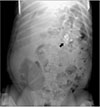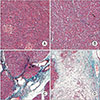Abstract
Purpose
Methods
Results
Figures and Tables
Fig. 1
View of the operation field. (A) The entire anterior surface of the pancreas was exposed, including the splenic and duodenal lobes. (B) After the injection of each substance into the pancreas (mixture of histoacryl and lipiodol or saline) or the pinprick, we marked the 3 different areas of the pancreas by clipping the connective tissue that was collinear to each treated area (arrows).

Fig. 2
Presence of the mixture of histoacryl and lipiodol was markedly revealed by X-ray film (arrow), which was taken on the 7th day following the injection for the survival model.

Fig. 3
Hardness of the pancreatic parenchyme was measured using a durometer in vivo (A) and ex vivo (B).

Fig. 4
Slide preparation was performed using the Masson trichrome staining method (original magnification x400). Fibrosis grade of the pancreas was estimated using the 4-stage scoring system as described by Wellner et al. [4] Briefly, the 4 grades include a normal pancreatic parenchyma without fibrotic changes (grade 0, A), mild fibrosis with thickened periductal fibrous tissue (grade 1, B), moderate fibrosis with marked sclerosis of the interlobular septa without evidence of architectural changes (grade 2, C), and severe fibrosis with detection of architectural destruction or acinar atrophy (grade 3, D).

Fig. 5
Focal change of the pancreatic parenchyme was confined to the mixture of histoacryl and lipiodol injection site (arrow) and not in the surrounding area, which was preserved to the normal structure of the pancreas (arrowhead), as shown in a cross-section (A) and during the histopathologic examination (B). Slide preparation was performed using the Masson trichrome staining method (original magnification x400).

Table 1
Comparative analysis of the hardness of harvested pancreatic tissue according to the injected substances

Values are presented as mean ± standard deviation.
a)A mixture of histoacryl and lipiodol (MLH) which was generated by mixing the Histoacryl (n-butylcyanoacrylate, Braun GmbH, Kronberg im Taunus, Germany) with lipiodol (Guerbert, Roissy, France) at a ratio of 1:4. b)Shore unit (S.U.) which reprents the tissual hardness checked by the durometer.
Table 2
Comparative analysis of the fibrosis grade of harvested pancreatic tissue according to the injected substances in the case of survival models

a)A mixture of histoacryl and lipiodol (MLH) which was generated by mixing the Histoacryl (n-butylcyanoacrylate, Braun GmbH) with lipiodol (Guerbert, Roissy, France) at a ratio of 1:4. b)The histopathologic examination was peformed only in the case of survival models (n = 13) because the sacrificed model that killed immediately after the laparotomy was not suitable to reflect the fibrotic change on pancreatic tissue. c)The fibrosis grade of pancreas was estimated using the 4-stage scoring system described by Wellner et al. [1].




 PDF
PDF ePub
ePub Citation
Citation Print
Print



 XML Download
XML Download